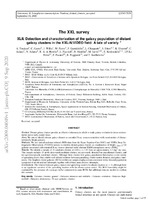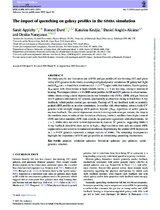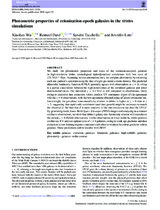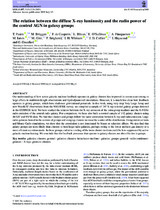| dc.contributor.author | Jarvis, M. | |
| dc.contributor.author | Trudeau, A. | |
| dc.contributor.author | Garrel, C. | |
| dc.date.accessioned | 2021-02-17T10:49:57Z | |
| dc.date.available | 2021-02-17T10:49:57Z | |
| dc.date.issued | 2020 | |
| dc.identifier.citation | Jarvis, M. et al. (2020). The XXL survey XLII. Detection and characterization of the galaxy population of distant galaxy clusters in the XXL-N/VIDEO field: A tale of variety . Astronomy & Astrophysics,642, A124 | en_US |
| dc.identifier.uri | 10.1051/0004-6361/202038982 | |
| dc.identifier.uri | http://hdl.handle.net/10566/5947 | |
| dc.description.abstract | Context. Distant galaxy clusters provide an effective laboratory in which to study galaxy evolution in dense environments and at early cosmic times.
Aims. We aim to identify distant galaxy clusters as extended X-ray sources coincident with overdensities of characteristically bright galaxies.
Methods. We use optical and near-infrared (NIR) data from the Hyper Suprime-Cam (HSC) and VISTA Deep Extragalactic Observations (VIDEO) surveys to identify distant galaxy clusters as overdensities of bright, zphot ≥ 0.8
galaxies associated with extended X-ray sources detected in the ultimate XMM extragalactic survey (XXL).
Results. We identify a sample of 35 candidate clusters at 0.80 ≤ z ≤ 1.93 from an approximately 4.5 deg2
sky area.
This sample includes 15 newly discovered candidate clusters, ten previously detected but unconfirmed clusters, and
ten spectroscopically confirmed clusters. Although these clusters host galaxy populations that display a wide variety
of quenching levels, they exhibit well-defined relations between quenching, cluster-centric distance, and galaxy luminosity. The brightest cluster galaxies (BCGs) within our sample display colours consistent with a bimodal population
composed of an old and red subsample together with a bluer, more diverse subsample.
Conclusions. The relation between galaxy masses and quenching seem to be already in place at z ∼ 1, although there
is no significant variation of the quenching fraction with the cluster-centric radius. The BCG bimodality might be
explained by the presence of a younger stellar component in some BCGs but additional data are needed to confirm
this scenario. | en_US |
| dc.language.iso | en | en_US |
| dc.publisher | ESO | en_US |
| dc.subject | Galaxies: clusters: general | en_US |
| dc.subject | Galaxies: distances and redshifts | en_US |
| dc.subject | Galaxies: evolution | en_US |
| dc.subject | Galaxies: highredshift | en_US |
| dc.subject | Galaxies: photometry | en_US |
| dc.title | The XXL survey XLII. Detection and characterization of the galaxy population of distant galaxy clusters in the XXL-N/VIDEO field: A tale of variety | en_US |
| dc.type | Article | en_US |




